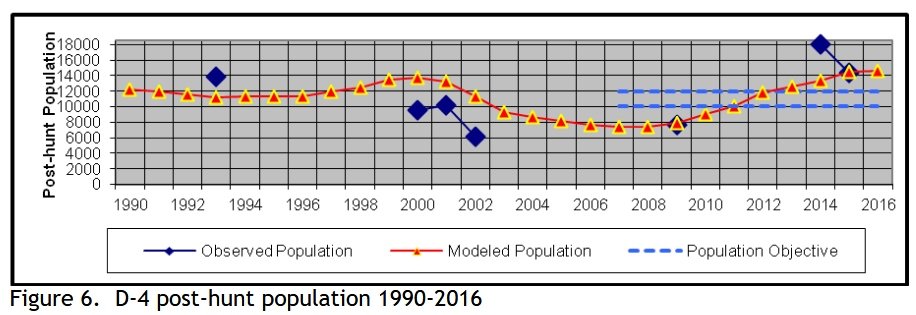PAhunter
Well-known member
Thanks @Oak. From that plan, modeled population was reduced by about 35% and stayed around that level from 2004-2009, then climbed steadily back up to higher numbers than sometime before 1990.

Also from that plan:
"Based on the Colorado Parks and Wildlife Commission (CPWC)
CWD policy at the time, CPW attempted to manage D-4 towards a reduced CWD
prevalence rate objective, and the 2001 HMP made changes to decrease
population size and lower the buck: doe ratio. The specific post-season
population objective was “less than 7,000 deer or sufficient to result in a less
than 1% prevalence across the DAU”. At the time, sample sizes sufficient to
show higher prevalence rates in male deer had not been reached, so no
guidance was available on an optimal sex ratio to help reduce disease
prevalence."
And a bit further on, after noting lack of hunter and landowner support for more drastic reductions in GMU 9:
"After significant internal and external input, a new HMP plan was approved in
2007 that called for increasing the population at least 50% to 10,000-12,000
deer. This population alternative received overwhelming public support and
was favored by CPW staff."
I gotta say I could never be a biologist in a state wildlife agency. Seems about the time you are beginning to see a change, social pressure comes in an tanks your experiment, so you never get a chance to really know the outcome.

Also from that plan:
"Based on the Colorado Parks and Wildlife Commission (CPWC)
CWD policy at the time, CPW attempted to manage D-4 towards a reduced CWD
prevalence rate objective, and the 2001 HMP made changes to decrease
population size and lower the buck: doe ratio. The specific post-season
population objective was “less than 7,000 deer or sufficient to result in a less
than 1% prevalence across the DAU”. At the time, sample sizes sufficient to
show higher prevalence rates in male deer had not been reached, so no
guidance was available on an optimal sex ratio to help reduce disease
prevalence."
And a bit further on, after noting lack of hunter and landowner support for more drastic reductions in GMU 9:
"After significant internal and external input, a new HMP plan was approved in
2007 that called for increasing the population at least 50% to 10,000-12,000
deer. This population alternative received overwhelming public support and
was favored by CPW staff."
I gotta say I could never be a biologist in a state wildlife agency. Seems about the time you are beginning to see a change, social pressure comes in an tanks your experiment, so you never get a chance to really know the outcome.




